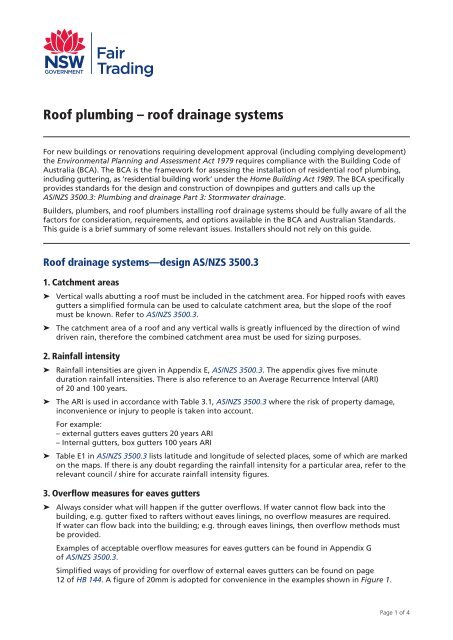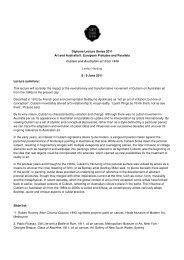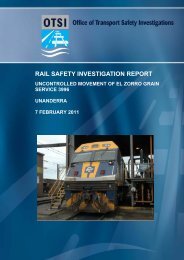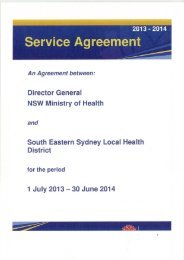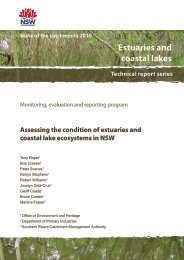Roof plumbing â roof drainage systems - NSW Fair Trading
Roof plumbing â roof drainage systems - NSW Fair Trading
Roof plumbing â roof drainage systems - NSW Fair Trading
You also want an ePaper? Increase the reach of your titles
YUMPU automatically turns print PDFs into web optimized ePapers that Google loves.
<strong>Roof</strong> <strong>plumbing</strong> – <strong>roof</strong> <strong>drainage</strong> <strong>systems</strong>For new buildings or renovations requiring development approval (including complying development)the Environmental Planning and Assessment Act 1979 requires compliance with the Building Code ofAustralia (BCA). The BCA is the framework for assessing the installation of residential <strong>roof</strong> <strong>plumbing</strong>,including guttering, as ‘residential building work’ under the Home Building Act 1989. The BCA specificallyprovides standards for the design and construction of downpipes and gutters and calls up theAS/NZS 3500.3: Plumbing and <strong>drainage</strong> Part 3: Stormwater <strong>drainage</strong>.Builders, plumbers, and <strong>roof</strong> plumbers installing <strong>roof</strong> <strong>drainage</strong> <strong>systems</strong> should be fully aware of all thefactors for consideration, requirements, and options available in the BCA and Australian Standards.This guide is a brief summary of some relevant issues. Installers should not rely on this guide.<strong>Roof</strong> <strong>drainage</strong> <strong>systems</strong>—design AS/NZS 3500.31. Catchment areas➤➤ Vertical walls abutting a <strong>roof</strong> must be included in the catchment area. For hipped <strong>roof</strong>s with eavesgutters a simplified formula can be used to calculate catchment area, but the slope of the <strong>roof</strong>must be known. Refer to AS/NZS 3500.3.➤➤ The catchment area of a <strong>roof</strong> and any vertical walls is greatly influenced by the direction of winddriven rain, therefore the combined catchment area must be used for sizing purposes.2. Rainfall intensity➤➤➤➤➤➤Rainfall intensities are given in Appendix E, AS/NZS 3500.3. The appendix gives five minuteduration rainfall intensities. There is also reference to an Average Recurrence Interval (ARI)of 20 and 100 years.The ARI is used in accordance with Table 3.1, AS/NZS 3500.3 where the risk of property damage,inconvenience or injury to people is taken into account.For example:– external gutters eaves gutters 20 years ARI– Internal gutters, box gutters 100 years ARITable E1 in AS/NZS 3500.3 lists latitude and longitude of selected places, some of which are markedon the maps. If there is any doubt regarding the rainfall intensity for a particular area, refer to therelevant council / shire for accurate rainfall intensity figures.3. Overflow measures for eaves gutters➤➤ Always consider what will happen if the gutter overflows. If water cannot flow back into thebuilding, e.g. gutter fixed to rafters without eaves linings, no overflow measures are required.If water can flow back into the building; e.g. through eaves linings, then overflow methods mustbe provided.Examples of acceptable overflow measures for eaves gutters can be found in Appendix Gof AS/NZS 3500.3.Simplified ways of providing for overflow of external eaves gutters can be found on page12 of HB 144. A figure of 20mm is adopted for convenience in the examples shown in Figure 1.Page 1 of 4
FIGURE 3 - PROVIDING FOR OVERFLOW OF EXTERNAL EAVES AND GUTTERS (20MM)Figure 1: Providing for overflow of external eaves and gutters (20mm)NG (Includes above ground stormwater <strong>drainage</strong>)20mmTECHNICAL SOLUTION 0.0420mm20mmORMWATER4.04 (Drainage)IDING FOR OVERFLOW OF EXTERNAL EAVES AND GUTTERS (20MM)20mm20mm20mm20mm20mm10mmSource: HB 114:2003 Figure 1FIGURE 4 - DESIGN EXAMPLE HOUSE PLAN20mm20mmDesign ExampleThe following example is shown to illustrate the procedure adopted by HB 114 to design eaves guttersand downpipes.A hypothetical house is to be constructed in an area that has an ARI of 130mm/hour. The plan is shown10mmin Figure 2. The <strong>roof</strong> pitch is 23°. Gutter overflow could cause significant damage, therefore overflowmeasures are required.N EXAMPLE HOUSE PLANFigure 2: Design example of house planGoods Shed NorthPO Box 536733 Bourke StreetMelbourneDocklands, Step Victoria 1: Determine 3008 the 5min/20 year ARI for the locality3008T: 1300 815 127www.pic.vic.gov.auFrom AS/NZS 3500. the ARI for this hypothetical house and area is 130mm/hour.PO Box 536T: 1300 815 127Page 5Melbournewww.pic.vic.gov.auStep 2: Select eaves gutter and gutter slopeThe eaves gutter selected is quad spouting with an effective cross sectional area of 6125mm 2 installedwith a slope of 1:500.Page 5Page 2 of 4
Step 3: Determine downpipe sizeFrom Table 3.3 in AS/NZS 3500.3, the minimum size downpipes compatible with spouting of 6125mm 2cross sectional area (installed at a 1:500 gradient) are 90mm diameter round or 100 x 50 rectangular.Note that a minimum gradient of 1:500 is preferred.Step 4: Select 100 x 50 rectangular downpipeFrom Figure 3.5 (A) in AS/NZS 3500.3, the maximum catchment per downpipe is 47m 2 .Step 5: Determine minimum number of downpipesTo calculate the minimum number of downpipes, divide the <strong>roof</strong> catchment area by the allowablemaximum catchment per downpipe.Min number of downpipes =<strong>roof</strong> catchment areaallowable maximum catchmentper downpipe= 223.847= 4.76m 2= Five downpipes are required(round up to the next whole number)Step 6: Determine the average catchment area per downpipeTo calculate the average catchment per downpipe, divide the <strong>roof</strong> catchment area by the numberof downpipes.Average catchment per downpipe =<strong>roof</strong> catchment areaNo. of downpipes= 223.85= 44.76m 2Step 7: Divide the <strong>roof</strong> into approximately equal catchment areas and determine downpipe positionsDivide the <strong>roof</strong> into five catchments and nominate the high points between downpipes (see Figure 3).Step 8: Select an overflow method if requiredThe example building requires overflow measures.AS/NZS 3500.3 provides various methods depending on the type of gutter used. For this job selectexample 1 from Figure 1 in HB 114 where the gutter is installed with the top of the front beada minimum of 20mm below the top of the fascia (see Figure 4).Installers must be aware of design requirements, and apply them on the job.Page 3 of 4
AND STORMWATEROF solution PLUMBING of 4.04 (Includes (Drainage) above ground stormwater <strong>drainage</strong>)TECHNICAL SOLUTION 0.04F AND STORMWATERte solution of 4.04 (Drainage)5 - ROOF DIVIDED INTO FIVE CATCHMENTSFigure 3: <strong>Roof</strong> divided into five catchmentsE 5 - ROOF DIVIDED INTO FIVE CATCHMENTSE 6 - EXAMPLE OF OVERFLOW METHOD6 - EXAMPLE Figure OF OVERFLOW 4: Example METHOD of overflow method20mm20mmSource: AS/NZS 3500.3:2003 Figure G1(a) modifiedShed Northurke Streetnds, Victoria 3008ed Northe Streets, Victoria 3008NotePO Box 536MelbournePO Box 536MelbourneT: 1300 815 127www.pic.vic.gov.auT: 1300 815 127www.pic.vic.gov.auPage 6➤➤ There are many possibilities for downpipe positions. In some cases, depending on <strong>roof</strong> shapeor building layout, extra downpipes may be needed as it is not always possible to achievePage 6approximately equal catchment areas.➤➤➤➤Valley gutters should be at high points to allow <strong>drainage</strong> away from internal angles.The sub catchment areas may not add exactly due to rounding off during calculations.➤➤In this particular example, as per step 5, no catchment area should exceed the allowable 47m 2.AcknowledgementThis guide is based on the Victorian Plumbing Industry Commission’s <strong>Roof</strong> Plumbing Technical SolutionSheet 0.04. <strong>NSW</strong> <strong>Fair</strong> <strong>Trading</strong> thanks the Victorian Building Commission and Plumbing IndustryCommission for permission to adapt their document.Standards Australia content in this guide is reproduced with permission from SAI Global under licence1107-c123. This content may not be reproduced or distributed without permission of the copyright holder.© State of New South Wales, through <strong>NSW</strong> <strong>Fair</strong> <strong>Trading</strong>, and© SAI Global, July 2011 (diagrams and figures)Note: Permission to reproduce this document must be sought from both parties.Page 4 of 4


